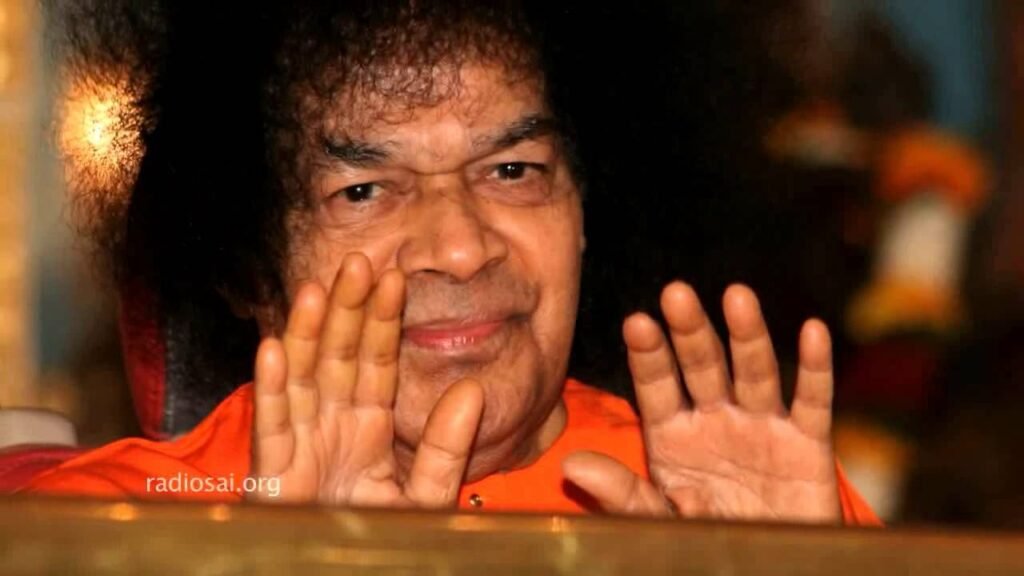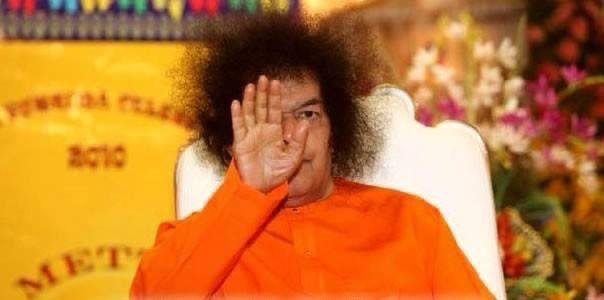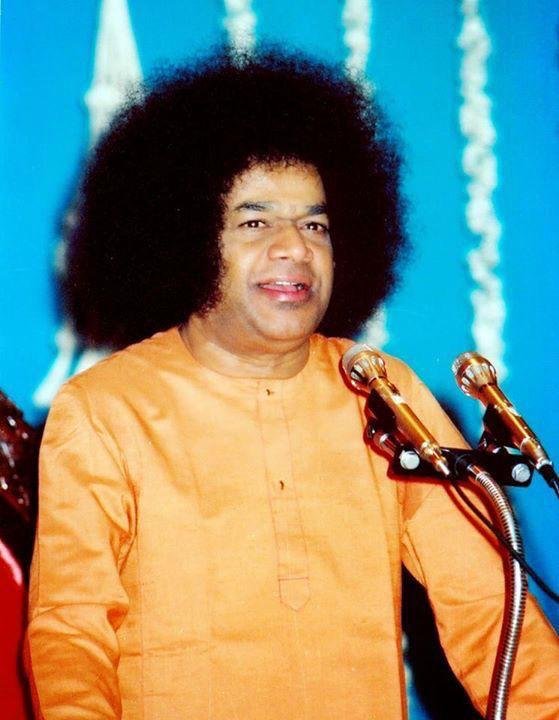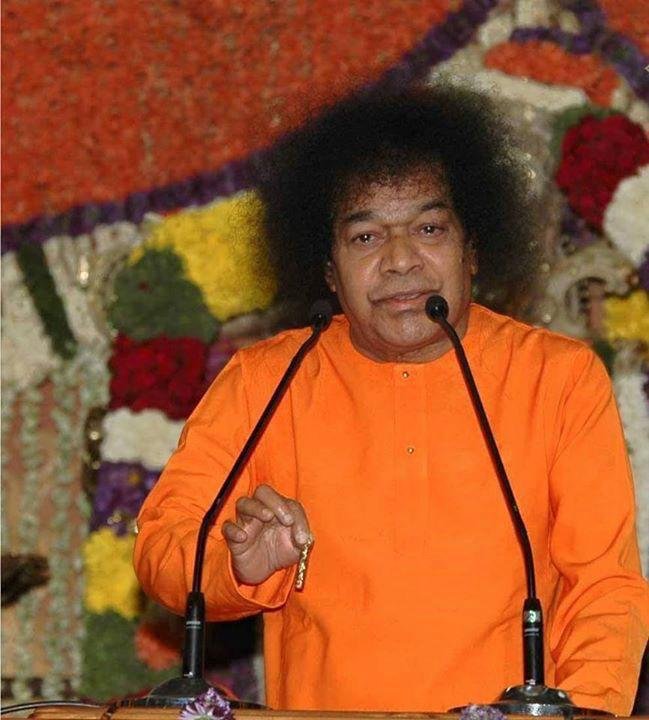CONVERSATIONS WITH SAI Satyopanishad
Satyopanishadô – Part fifteen
Direct Directions from the Divine
Chapter 5:ô Concepts
Prof. Anil Kumar: Swami! We hear about pancha koshas, the five sheaths, the pancha pranas, the five vital airs, and panchendriyas, the five organs. Do they cover our spirit, atma? Are they obstacles to atmic bliss? What exactly is their position and role in our body?
Bhagavan: The whole world is made of five elements:ô Earth, fire, water, air and space. Man is the product of these five elements, besides his temperament.ô Ragaô or attachment,ô dvesaô or hatred, andô bhayaô or fear, originate inô akasa, space. Our breathing process, movements like walking or other body movements are due toô vayu, wind.
Hunger, thirst and sleep are the effects ofô agni, fire. Phlegm, blood, bile, urine, etc., are the outcome ofô jala, water. Skin, muscles, bones, nails, hairs, nerves are ofô prthvi, matter. Therefore, all the five elements are equally distributed in everyone. No one can truly be considered superior to any other.

The human body has five sheaths, theô Pancha koshas. The first one isô annamayaô kosha, the sheath of food, the second isô pranamayaô kosha, the sheath of life, and the third isô manomayaô kosha, the sheath of mind. The fourth isô vigyanamayaô kosha, the sheath of knowledge and finallyô anandamayaô kosha, the sheath of bliss.
One sheath encloses the other. You know rice grains are enclosed within husks. Therefore, a rice grain is within the sheath of husk. For the tamarind seed, tamarind pulp is the sheath. An embryo is within the sheath of its mother’s womb.
Annamayaô koshaô is a sheath which coversô pranamayaô kosha. This enclosesô manomayaô kosha,ô the sheath of the mind. This coversô vigyanamayaô kosa, sheath of wisdom, which finally enclosesô anandamayaô kosa, the sheath of bliss.
Then comesô manomayaô kosha, the mental sheath consisting of five organs of perception (jnanendriyas), and the mind, which is full of thoughts and counter-thoughts. The fourth isô vigyanamaya kosha, the sheath of knowledge, of sound, touch, form, taste and smell, which constitutes theô buddhi, intellect.
Everyone has an equal right to know and experience the atma, self. To attain such an awareness, self-enquiry is very necessary. However, an intense and deep desire is essential to know and experience atma.
The innermost sheath isô anandamayaô kosaô (sheath of bliss). In order to enable yourself to experience this state of bliss, you will have to practice all that you theoretically know and do what you are supposed to. Likewise, you should understand the principle ofô samatva, equality, andô ekatva, unity, and experienceô daivatva, divinity. This leads you to a state when you will not hate anyone.
Everyone has an equal right to know and experience theô atma, self. To attain such an awareness, self-enquiry is very necessary. However, an intense and deep desire is essential to know and experienceô atma. Just like a seed within a fruit, as a copper wire within a plastic covering, butter in milk, sugar in the sugarcane, oil within sesame seeds and fire in wood,ô atmaô is encased withinô pancakosas,ô pancendriyasô andô pancapranasô (five life sheaths, five sense organs and five life principles).
Prof. Anil Kumar:ô Swami! We come across words likeô manasô (mind),ô buddhiô (intellect),ô cittaô (consciousness), andô ahamkaraô (egoism). How are we to understand and correlate them? How do they differ from one another? It is our good fortune that Swami explains in simple ways, terms ever so complex.
Bhagavan:ô Here is an illustration. Consider a Brahmin. When he conducts ceremonies like weddings, you call himô purohit, priest; when he reads out from the almanac at your home theô tithi, lunar phase, theô varamô day of the week,ô naksatra, star, etc. you call him theô pancanga Brahmin; when he prepares food in your home, you call him the brahmin cook.
Another illustration. Your wife addresses you in Telugu asô emandi, (Oh, you! Please, Sir!) because addressing the husband by name is not considered proper. Your child calls you ‘Father’ and your student addresses you as ‘Sir’. But, you are, after all, only one individual, aren’t you!
One and the same faculty has different names:ô manasô or mind when engaged in thinking;ô chittaô or awareness in a state of equanimity devoid of plans or decisions;ô buddhiô or intellect while exercising discrimination; andô ahamkaraô or egoism when introducing oneself or referring to oneself as ‘I’. All these are one, but named differently according to their function.

What is to be controlled is the mind. When you have thatô nigrahamô (control), you obtain God’sô anugraham, grace. Once you consider something as evil, do not allow it to enter the mind. The behaviour of trees and animals is regulated byô prakrti, Nature. Only man is disobeying the commands of God and has become depraved. There is only one solution.
What is to be controlled is the mind. When you have that nigraham (control), you obtain God’s anugraham, grace. Once you consider something as evil, do not allow it to enter the mind. The behaviour of trees and animals is regulated by prakrti, Nature. Only man is disobeying the commands of God and has become depraved. There is only one solution.
Another little illustration: Tie upô kamadhenu, the wish fulfilling cow, of your body with theô pasha, rope, ofô prema, love, to the post calledô nama, chanting the Name of the Lord. That is enough. You gain control over the mind. Then, on theô chitta, awareness, devoid of the turmoil of thoughts, is imprinted the form of God.ô Buddhiô undertakes fundamental discrimination; the ‘I’ which has been egoistic cognises its own true nature asô atmaô and realises the innermost Self in all beings. This isô adhyatmika, spirituality.
Prof. Anil Kumar:Swami! You stress chittasuddhi, purification of our heart, but how is one to accomplish it?
Take for example, this kerchief. This is white in colour. It becomes dirty as I use it. I give it to a washerman to wash and return it. When he brings it, it looks white and bright as before. It was so before and it is so after a wash, but it was dirty in between due to use. The washerman did not paint the kerchief white. He only removed the dirt. So too, like a kerchief, your mind is also pure which becomes impure due to your desires and thoughts. Once you remove the impurities from the mind, it will become pure.
Prof. Anil Kumar: Swami!ô Swami! Now it is clear thatô chittasuddhiô is lacking in us due to our bad thoughts and bad deeds. We have certain weaknesses, lapses, bad qualities and thoughts. As you have said unless we get over them,ô chittasuddhiô cannot be attained. The mind gets polluted very often. How is one to control bad qualities?
Bhagavan:ô It all depends upon your determination and your understanding of the intensity and the gravity of the problem. It needs an honest and sincere attempt on your part.

A small example: You are moving freely without any hesitation and fear in this room. There lies a rope in one corner. But, if you come to know that it is not a rope as you have been thinking it to be, but a snake, would you move freely in that room any longer? You know that it is dangerous to be anywhere near a poisonous snake. You know that you will die if that snake bites you, and so you keep off from that place. Similarly, when you are aware of the danger or harm you will be put to, you will definitely stop your misdeeds
You keep on holding the rope till you know that it is just a rope. But once you realise that it is a snake, you drop it down immediately, because of the fear of death.
It is also strange to notice that some seekers undergo rigorous discipline for a set period of time during which they lead a perfect life without any trace of a bad quality. But after that avowed period of discipline they resume their previous bad habits with redoubled vigour.
This is a big mistake. That which holds you for some time is artificial. Here, withdrawal from bad habits is not due to the realisation of the evil effects.
So long as you think that these bad thoughts and evil deeds make you happy, you continue to be in the same frame of mind. But, when you know that they are dangerous, you will not hanker after them. Therefore, first of all, you must identify your own bad qualities and then give them up gradually, one after another, until you are perfect.
Here is an example. You see the ceiling fan rotating there. Now, if you switch it off, it will not stop rotating immediately. The three blades stop moving slowly. Therefore, in full knowledge of the possible harm and the evil effects, you should give up your bad habits slowly.
Here is an example. You see the ceiling fan rotating there. Now, if you switch it off, it will not stop rotating immediately. The three blades stop moving slowly. Therefore, in full knowledge of the possible harm and the evil effects, you should give up your bad habits slowly.
Prof. Anil Kumar:ô Swami!ô Pranayamaô (breath control), some say, is important on the spiritual path. Would you please tell us about it?
Bhagavan:ô Pranayama, breath control, has to be undertaken in an exact and perfect way under the care and guidance of a Guru. It leads to danger if it is done imperfectly and irregularly.
There are chiefly three steps inô pranayamaô or breathing exercise. The first one isô purakam, inhalation. The second is holding the breath or the air breathed in; this is calledô kumbhakam, retention. The third stage is exhalation orô rechakam.
Satyopanishadô – part Sixteen
Direct Directions from the Divine
Chapter 5:ô Concepts
Prof. Anil Kumar:ô Swami! We have many qualitiesô tamasikaô (like laziness, dullness, etc.), rajasikaô (like aggressiveness, ego, etc.) andô sattvikaô (being pious).ô Do they change at any time? How are we to ennoble ourselves? Sometimes these attributes may be responsible for conflicts with our colleagues in the office. What is to be done under these circumstances? Kindly give us a solution to this problem that we encounter everyday?
Bhagavan:ô The whole world revolves round these three attributesô tamasika, rajasika and sattvika.ô Every individual has these three attributes working like the three blades of a fan. But in a person, the quality which dominates the other two, decides their nature and total personality, nay, their very destiny as a whole.

He is a pious man whoseô sattvikaô quality dominates hisô rajasikaô andô tamasikaô qualities. He is an emotional, passionate, active man if hisô rajasikaô quality dominates hisô sattvikaô andô tamasikaô qualities. He is a dull, inactive and passive man if he is dominated by theô tamasikaô nature. Thus, everyone has these three attributes.
For instance, in an eyeball don’t you see all the three colours – white, red, and black? They symbolise these three traits. Watch the Sunrise. You will notice three colours – red, white and black again indicating three attributes.
Therefore, a tamasika nature can be converted into rajasika by volitional action, which can be further transformed into sattvika by bhakti and jnana, that is, devotion and awareness. This is sadhana or spiritual practice.
In fact, one should salute respectfully the action he does.ô Tasmai namah karmane, ãmy salutations to the action given or assigned to meã. Therefore, aô tamasikaô nature can be converted intoô rajasikaô by volitional action, which can be further transformed intoô sattvikaô byô bhaktiô andô jnana, that is, devotion and awareness. This isô sadhanaô or spiritual practice.
Byô atmavicara, self-enquiry, you can improve and change your nature.ô When any lower or animal qualities like wavering of the mind, excessive sleep, gluttony, etc. crop up, immediately say to yourself at least ten times. “I am a man, I am not an animal.” Then, you will be able to get over them. Do your duty sincerely. Don’t be pompous. Don’t show off or do any stunt. Always be sure that God notices everything that you do, though others may not. Do your duty with love.
Duty with love is Desirable.
Duty without love is Deplorable,
Love without duty is Divine.
If you offer all your work and the fruits thereof to God, your work will be transformed into worship.
You may not agree with your colleagues in your office. Your temperament may be incompatible with theirs, sometimes leading to controversies and in-fights, and you may, as a result, lose your peace of mind. So, don’t have too close a relationship with too many people. Say ãhello, helloã to everyone, ‘how are you’ to all those you meet and end with ‘goodbye’. That’s all and nothing more.
Today, there is no real social service. Everything is either slow-service or show-service. You should have a feeling that what you do is not for anybody but for your own satisfaction and happiness. Whatever you do, do it for the satisfaction of your conscience.
You shouldn’t do anything for praise or appreciation by others. Your conscience is God. Know that character is most important and you should never compromise on this score. What is always necessary for success in life is cooperation. But nowadays, we find only operation.
You should have a feeling that what you do is not for anybody but for your own satisfaction and happiness. Whatever you do, do it for the satisfaction of your conscience. You shouldn’t do anything for praise or appreciation by others. Your conscience is God. Know that character is most important and you should never compromise on this score. What is always necessary for success in life is cooperation.
By joining good company (satsang), listening to the teachings of great masters and seers, and above all with God’s grace, you can change your attitudes and mentality.ô By Buddha’s teaching, the cruel Angulimala and by Narada’s instructions Ratnakara (who became sage Valmiki later) were transformed. Visvamitra who was a Rajarshi, a sage among kings, became a Brahmarshi, a sage ever immersed inô Brahman,ô by the direction of Vasishtha. Visvamitra thus became theô mitra, friend of theô visva, universe.
Bhagavan:ô There is no illusion whatsoever. What exists is onlyô brahman, the Cosmic Soul. The so-called illusion orô mayaô is only your imagination. There is onlyô Brahman. Nothing more! The body attachment is illusion,ô mayaô orô bhrama.
A simple example: Here is a huge tree under which you see its shadow, don’t you? The branches and the leaves are the cause of the shade. As the sunlight falls on the tree you see the shade beneath the tree. Here you have to know one important point.
What exists is only brahman, the Cosmic Soul. The so-called illusion or maya is only your imagination. There is only Brahman. Nothing more! The body attachment is illusion, maya or bhrama.

Prof. Anil Kumar:ô Swami! How are we to get overô mayaô or illusion?
Bhagavan: There is no maya. It is your own creation. How is it then you want to get over that, which does not exist at all?
In the night, seeing a rope, you mistake it for a serpent and you are very much stricken with fear. Later on, enquiry reveals that it is only a rope and not a serpent. What you should know here are two points: Neither the snake disappears, nor does the rope appears specially to give you relief. All along, it has been a rope. You are the only one who is mistaken by taking a rope for a serpent. So also, the reality isô brahmanô orô atmaô and the rest isô bhrama, or illusion or imagination.
Prof. Anil Kumar:ô Swami! It is often said and felt that none escapesô mayaô or illusion. Everyone falls a victim to the influence ofô maya. So, man is prone to delusion. Then Swami, a person who has known whatô mayaô is and has been out ofô maya, how is it that he gets into the trap again?
Bhagavan:ô Think of this situation. When it is dark what happens to light? Where does it go? Similarly, when there is light, where does the darkness that was present till the light came, go?
Absence of light is darkness.
Darkness does not flow or run away. Because of the light, it is not noticed. Once the light is put off, it will be dark as before. Here light is wisdom, darkness is ignorance, orô maya,ô or delusion, orô avidya. To dispel the darkness the only thing to do is light a candle.
So long as it is on the move of sadhana, the dust of illusion stays behind. But, if the bus of life stops or halts sadhana, the dust of delusion will get into life. So, it is sadhana that keeps you unaffected by delusion. If you stop sadhana you will again become a victim of maya.
Your question is, how the darkness of ignorance comes back again having been dispelled once already by the light of wisdom.

Prof. Anil Kumar:ô Swami! Illusion is a non-atmicô feeling or worldly approach. To identify myself with that which I am not is illusion. Truly speaking, the “I” we often speak of is in reality onlyô atma; nothing else. How is one to know this truth, and to recognise and experience this truth? Kindly tell us about this Swami!




















































